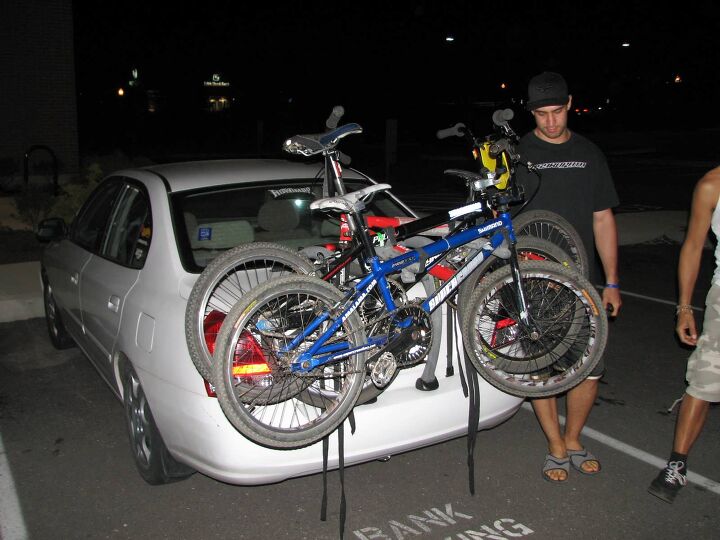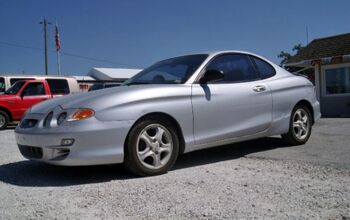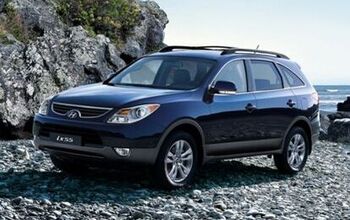Capsule Review: 2001 Hyundai Elantra

We’re coming to the end of KOREA! WEEK! and we still haven’t answered the question: When did Hyundai start becoming a serious player in this market? When did the image change from Deadly Sin to default-choice affordable car? One can go back as far as the second-generation Excel, which cracked the reliability equation while still being rust-prone as all get out. Alternately, perhaps it wasn’t until the arrival of the current Sonata that the brand became worthy of being chosen by the frozen Middle American masses.
The truth probably lies somewhere in the middle, and I’d suggest that the car you see above was the true turning point. The first-generation Elantra (Lantra to the Cammy Corrigan crowd) was pleasant enough, but it didn’t even pretend to compete with Civics and Corollas. Hyundai was assumed to know its place, and that place was among the credit criminals, desperately poor, and the hopelessly stupid. Ten years ago, however, the Elantra woke up and decided that nobody was going to put it in a corner.
In 1999, I was winding down my spectacularly unsuccessful professional BMX career, in which I had racked up over a dozen broken bones and some absolutely hilarious-sounding internal injuries (ever have your hipbone shoved through your bladder? Howabout a femur broken into four free-floating pieces?) and I’d decided to concentrate on training younger riders. I’d been corresponding with some up-and-coming pros in South America and I suggested that they stay with me for a while and train. Five of them ended up showing up. Three have since quit the sport and become respected members of government and industry around the world. One broke his neck that Christmas but has since mounted a comeback and won professional events all around North and South America.
One of them simply never left the country, marrying an American girl and pursuing a pro BMX career here. We call him Jamalama, and he’s become a member of the family in many ways.
You can see why I got sick of racing against kids like him and decided to go beat up on orthodontists at Porsche Club events. Jamalama owned two Saabs in a row — an Eighties 900 Turbo which died at 260,000 miles and a 900NG Turbo which was hit from behind and totaled at the 150K mark — but after seeing the reliable service my brother had gotten from his Tiburon and his wife’s 2001 Elantra, the young rider decided to give Hyundai a shot.
We bought the car in 2005; it had 72,000 miles on it. Since then, it’s gone to pretty much every state in the Union where a BMX race has been held. As of this morning, it’s showing 154,967 on the odo. Repairs have been light: the fuel tank sensor went out and it’s gone through a pair of ball joints and front brake calipers. This is the kind of reliability which used to be synonymous with “Toyota”. Year after year, it’s started and run without effort or difficulty. This matches the service that my brother’s wife got from her Elantra, which she eventually gave to our mother and which we sold for $3000 with 95,000 trouble-free miles on the odometer.
Let’s put this another way: in the first year I had my 2005 Phaeton V8, it racked up more days in the service bay than two 2001 Elantras did over a combined 14 vehicle-years and 160,000 miles in our possession. Service on these little cars is trivially easy; I can do brake pads on an Elantra in an hour and I’m not known for being a solid mechanic. And although the ladies in the family were easy on their Elantra, Jamalama seems to continually coming up with ways to abuse his:
It’s hard to overestimate the impact that producing cars of this quality and durability can have on a manufacturer’s reputation. This is good, because the Elantra occasionally falls short on the desirability side of the equation. As with the Tiburon, the control efforts are artificially light and more than lightly artificial. All the Elantras I’ve seen of this generation have what I think of as a “Korean smell”; the plastics simply aren’t what we are used to from the domestic and Japanese manufacturers and their outgassing has a decidedly unique quality. I’m certain that a Korean customer looking at one of the rare Chevrolet Cobalts that made it into the country would have a similar olfactory experience. Eventually you get used to it.
The odd ergonomics aren’t as easy to overlook, and the selection of interior materials ranges from “depressing” to “ridiculous”. Luckily for Hyundai, however, their gradual improvement in this regard happened to come just as Toyota, Honda, and Nissan were looking for ways to cut costs out of their small cars. The ’93 Corolla felt like a little LS400, but the ’01 Corolla failed to continue on that admirable path and the price didn’t reflect the savings enjoyed by its manufacturer. Put plainly, the Corolla was the default choice, but the Elantra was the smart choice, particularly if you expected to drive it long enough for the reduced resale value to not be an issue.
When my brother’s wife bought her Elantra, I called it “a good car for the price”. A decade later, I’ve revised my opinion on these Elantras. They aren’t good cars for the price. They are simply good cars.

More by Jack Baruth
Latest Car Reviews
Read moreLatest Product Reviews
Read moreRecent Comments
- Analoggrotto I don't see a red car here, how blazing stupid are you people?
- Redapple2 Love the wheels
- Redapple2 Good luck to them. They used to make great cars. 510. 240Z, Sentra SE-R. Maxima. Frontier.
- Joe65688619 Under Ghosn they went through the same short-term bottom-line thinking that GM did in the 80s/90s, and they have not recovered say, to their heyday in the 50s and 60s in terms of market share and innovation. Poor design decisions (a CVT in their front-wheel drive "4-Door Sports Car", model overlap in a poorly performing segment (they never needed the Altima AND the Maxima...what they needed was one vehicle with different drivetrain, including hybrid, to compete with the Accord/Camry, and decontenting their vehicles: My 2012 QX56 (I know, not a Nissan, but the same holds for the Armada) had power rear windows in the cargo area that could vent, a glass hatch on the back door that could be opened separate from the whole liftgate (in such a tall vehicle, kinda essential if you have it in a garage and want to load the trunk without having to open the garage door to make room for the lift gate), a nice driver's side folding armrest, and a few other quality-of-life details absent from my 2018 QX80. In a competitive market this attention to detai is can be the differentiator that sell cars. Now they are caught in the middle of the market, competing more with Hyundai and Kia and selling discounted vehicles near the same price points, but losing money on them. They invested also invested a lot in niche platforms. The Leaf was one of the first full EVs, but never really evolved. They misjudged the market - luxury EVs are selling, small budget models not so much. Variable compression engines offering little in terms of real-world power or tech, let a lot of complexity that is leading to higher failure rates. Aside from the Z and GT-R (low volume models), not much forced induction (whether your a fan or not, look at what Honda did with the CR-V and Acura RDX - same chassis, slap a turbo on it, make it nicer inside, and now you can sell it as a semi-premium brand with higher markup). That said, I do believe they retain the technical and engineering capability to do far better. About time management realized they need to make smarter investments and understand their markets better.
- Kwik_Shift_Pro4X Off-road fluff on vehicles that should not be off road needs to die.





































Comments
Join the conversation
My sister put 180K trouble free miles on her early 80s Excel...perhaps the only one to do so but still it showed it could be done. I purchased an 02 GT hatch as its only 5 door competitors w/ABS available at the time were either way more expensive or not actually available (Focus 3door only, Matrix/Vibe & VW to spendy, Mazda Protage 5, with ABS according to the dealer on its way from the factory for almost 2 months before I gave up and got the Elantra). I've also put 4 rear and 2 front wheel bearings in it, only 2 of which were not under warranty, and the new ones seem to be of higher quality then the originals. Other then that it's been pretty much standard wear items and the onset of rust. Now with 135K I may out do my sisters Excel if the Vermont road salt doesn't eat the body. I don't Love the car but I would happily buy it again if I were in the same position.
A friend bought a 2001 Elantra brand new in 2001. He sold it earlier this year with 145,000 miles on it for $3,500. During his 9 years of ownership, he performed the scheduled maintenance at the dealership and nothing else. Over 145,000 miles, nothing ever broke. I mean that quite literally, not a single thing on the car that wasn't a wear item ever needed repair or replacing. Even compared to my own mother's multitudes of Lexus RX's (IMO the former staple of durability), this thing was amazing. $14,000 for the car and $0 on repairs in 9 years.